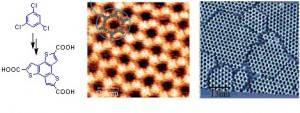This research is the result of a collaboration between French, Italian, Australian, and Canadian researchers. From a Jan. 5, 2016 news item on *phys.org,
An international team of researchers including Professor Federico Rosei and members of his group at INRS (Institut national de la recherche scientifique) has developed a new strategy for fabricating atomically controlled carbon nanostructures used in molecular carbon-based electronics. An article just published in the prestigious journal Nature Communications presents their findings: the complete electronic structure of a conjugated organic polymer, and the influence of the substrate on its electronic properties.
A Jan. 5, 2016 INRS news release by Gisèle Bolduc, which originated the news item, indicates this is the beginning rather than an endpoint (Note: A link has been removed),
The researchers combined two procedures previously developed in Professor Rosei’s lab—molecular self-assembly and chain polymerization—to produce a network of long-range poly(para-phenylene) (PPP) nanowires on a copper (Cu) surface. Using advanced technologies such as scanning tunneling microscopy and photoelectron spectroscopy as well as theoretical models, they were able to describe the morphology and electronic structure of these nanostructures.
“We provide a complete description of the band structure and also highlight the strong interaction between the polymer and the substrate, which explains both the decreased bandgap and the metallic nature of the new chains. Even with this hybridization, the PPP bands display a quasi one-dimensional dispersion in conductive polymeric nanowires,” said Professor Federico Rosei, one of the authors of the study.
Although further research is needed to fully describe the electronic properties of these nanostructures, the polymer’s dispersion provides a spectroscopic record of the polymerization process of certain types of molecules on gold, silver, copper, and other surfaces. It’s a promising approach for similar semiconductor studies—an essential step in the development of actual devices.
The results of the study could be used in designing organic nanostructures, with significant potential applications in nanoelectronics, including photovoltaic devices, field-effect transistors, light-emitting diodes, and sensors.
About the article
This study was designed by Yannick Fagot-Revurat and Daniel Malterre of Université de Lorraine/CNRS, Federico Rosei of INRS, Josh Lipton-Duffin of the Institute for Future Environments (Australia), Giorgio Contini of the Italian National Research Council, and Dmytro F. Perepichka of McGill University. […]The researchers were generously supported by Conseil Franco-Québécois de coopération universitaire, the France–Italy International Program for Scientific Cooperation, the Natural Sciences and Engineering Research Council of Canada, Fonds québécois de recherche – Nature et technologies, and a Québec MEIE grant (in collaboration with Belgium).
Here’s a link to and a citation for the paper,
Quasi one-dimensional band dispersion and surface metallization in long-range ordered polymeric wires by Guillaume Vasseur, Yannick Fagot-Revurat, Muriel Sicot, Bertrand Kierren, Luc Moreau, Daniel Malterre, Luis Cardenas, Gianluca Galeotti, Josh Lipton-Duffin, Federico Rosei, Marco Di Giovannantonio, Giorgio Contini, Patrick Le Fèvre, François Bertran, Liangbo Liang, Vincent Meunier, Dmitrii F. Perepichka. Nature Communications 7, Article number: 10235 doi:10.1038/ncomms10235 Published 04 January 2016
This is an open access paper.
*’ScienceDaily’ corrected to ‘phys.org’ on Tues., Jan. 5, 2016 at 1615 PST.
